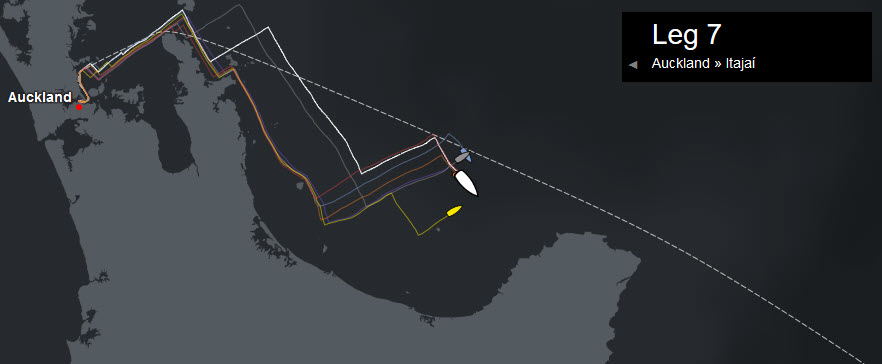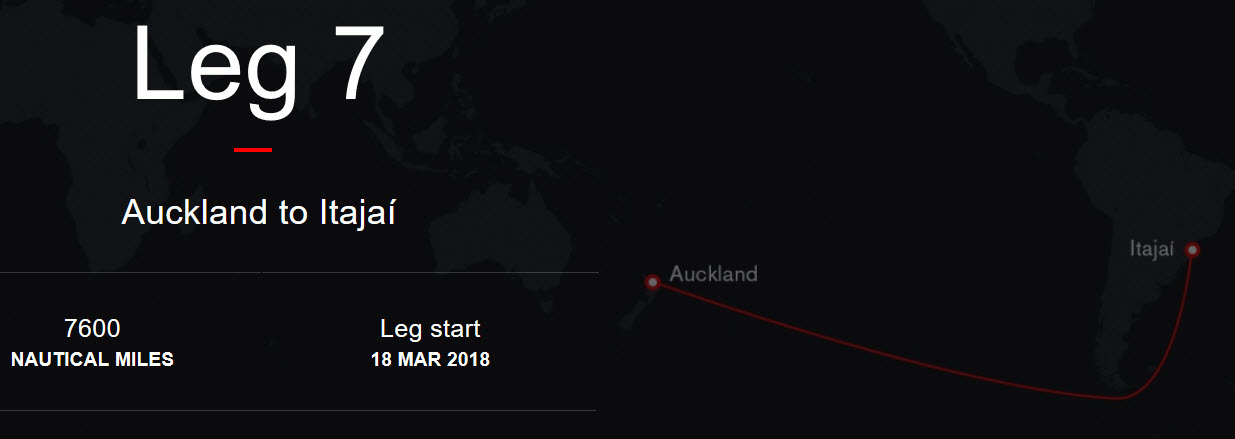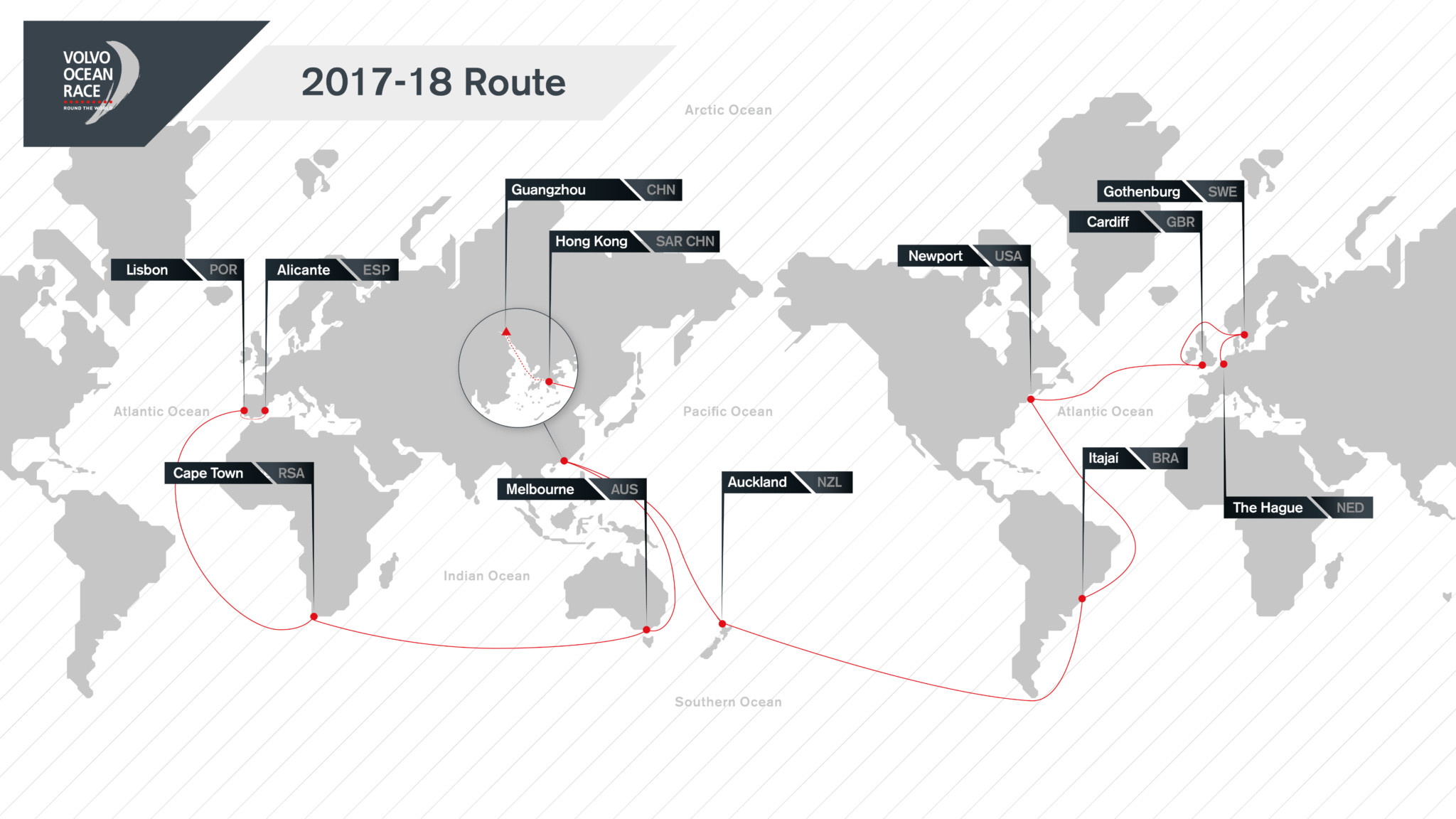Volvo Ocean Race: Grueling leg begins
Published on March 18th, 2018
Auckland, New Zealand (March 18, 2018) – It was a spectacular start to Leg 7 of the Volvo Ocean Race as the fleet left Auckland at 1400 local time (0200 UTC) in perfect conditions.
The sun was out, the wind was near 20 knots, and as they have for 10 stopovers, the Auckland fans took to the water by the thousands to farewell the fleet. It wasn’t a surprise – over the course of the Auckland stopover, over 500,000 fans came through the Race Village at the Viaduct Basin.
It was MAPFRE, the overall race leader, who made the best start to lead the fleet around a loop of the Waitematā Harbour and out into the Hauraki Gulf, with Dongfeng, Team Brunel and Turn the Tide on Plastic in close and giving chase.
In a return to the heritage of the event, Leg 7 of the Volvo Ocean Race will take the teams on a 7,600* nautical mile journey into the Southern Ocean, and around the iconic Cape Horn, before returning to the Atlantic Ocean towards the finish in Itajaí, Brazil.
“100% of the sailors that have done this leg have at one moment said it is too hard or too tough,” said Charles Caudrelier, the skipper of Dongfeng Race Team. “But when you pass Cape Horn you have a huge feeling of pride that you have faced your fears.”
“We’re going into one of the more gruelling legs of the race,” added Brunel’s Peter Burling, a hero in New Zealand for bringing the America’s Cup home last summer.
“The biggest challenge is the endurance aspect, having to keep the intensity high through some very difficult conditions… It’s going to be pretty tough for any of us Kiwis to leave here, but we’re all pretty excited to get into it.”
The initial Ice Exclusion Zone will allow the teams to sail as far south as 59-degrees south latitude, well into the ‘Furious Fifties’, where wind and waves circle the planet unimpeded by land, allowing them to build to fearsome levels. It will be very cold that far south, and the routing will take the fleet to the most remote part of the world, Point Nemo, where the international space station is closer than any point of land.
There is a balance to be struck on this leg, between pushing the crew and equipment hard in the quest for victory, and ensuring the team is able to finish the leg at all.
“This is a part of the world where sometimes you have to forget about the race and just take care of the people and the boat,” noted Caudrelier. “It’s a special place, sailing in the South – the sea is bigger, the wind is stronger, so you need to be mindful.”
The teams are getting straight into it – after leaving the final turning mark, the forecast is for an upwind slog into a 30-knot easterly as they aim to clear the Coromandel Peninsula and then the East Cape of New Zealand, before turning south in search of the low pressure systems that will power them towards Cape Horn, some 11 days away.
“It’s going to be upwind and bumpy until East Cape,” said Vestas 11th Hour Racing navigator Simon Fisher. His team is returning to the race after retiring from Leg 4 and missing the leg into Auckland while repairing damage to their hull.
“Going around Cape Horn represents a real milestone in the race. It’s a big thing to get around the Horn and it’s a moment of celebration for everyone on board as it means the end of the Southern Ocean and back to the relative safety of the South Atlantic.
“But by no means is it a moment to relax as some of the biggest challenges of this leg can be found between Cape Horn and the finish in Itajaí.”
The initial ETA for the finish in Itajaí, Brazil is between April 4th and 6th.
For crew lists … click here.
* Distance: The race organizers choose to estimate the tactical distance for each leg rather than list the actual distance, an unusual decision that’s revealed once the race starts and the tracker lists the actual distance to finish. The VOR says Leg 7 is 7600 nm whereas the truth is more like 6623 nm.
Race details – Tracker – Scoreboard – Race route – Facebook – YouTube
Leg 7 – Position Report (19:00 UTC)
1. MAPFRE (ESP), Xabi Fernández (ESP), 6471.3 nm DTF
2. Dongfeng Race Team (CHN), Charles Caudrelier (FRA), 0.9 nm DTL
3. Team Brunel (NED), Bouwe Bekking (NED), 1.6 nm DTL
4. Team AkzoNobel (NED), Simeon Tienpont (NED), 2.1 nm DTL
5. Vestas 11th Hour Racing (DEN/USA), Charlie Enright (USA), 2.9 nm DTL
6. Team Sun Hung Kai/Scallywag (HKG), David Witt (AUS), 4.3 nm DTL
7. Turn the Tide on Plastic (POR), Dee Caffari (GBR), 4.9 nm DTF
DTF – Distance to Finish; DTL – Distance to Lead
Overall Results (after 6 of 11 legs)
1. MAPFRE (ESP), Xabi Fernández (ESP), 39 points
2. Dongfeng Race Team (CHN), Charles Caudrelier (FRA), 34
3. Team Sun Hung Kai/Scallywag (HKG), David Witt (AUS), 26
4. Team AkzoNobel (NED), Simeon Tienpont (NED), 23
5. Vestas 11th Hour Racing (DEN/USA), Charlie Enright (USA), 23
6. Team Brunel (NED), Bouwe Bekking (NED), 20
7. Turn the Tide on Plastic (POR), Dee Caffari (GBR), 12
2017-18 Edition: Entered Teams – Skippers
• Team AkzoNobel (NED), Simeon Tienpont (NED)
• Dongfeng Race Team (CHN), Charles Caudrelier (FRA)
• MAPFRE (ESP), Xabi Fernández (ESP)
• Vestas 11th Hour Racing (DEN/USA), Charlie Enright (USA)
• Team Sun Hung Kai/Scallywag (HKG), David Witt (AUS)
• Turn the Tide on Plastic (POR), Dee Caffari (GBR)
• Team Brunel (NED), Bouwe Bekking (NED)
Background: Racing the one design Volvo Ocean 65, the 2017-18 Volvo Ocean Race begins in Alicante, Spain on October 22 2017 with the final finish in The Hague, Netherlands on June 30 2018. In total, the 11-leg race will visit 12 cities in six continents: Alicante, Lisbon, Cape Town, Melbourne, Hong Kong, Guangzhou, Auckland, Itajaí, Newport, Cardiff, Gothenburg, and The Hague. A maximum of eight teams will compete.
Source: Volvo Ocean Race












 We’ll keep your information safe.
We’ll keep your information safe.